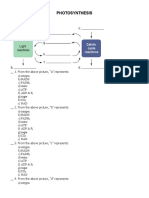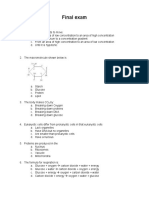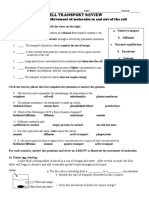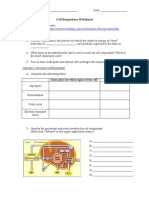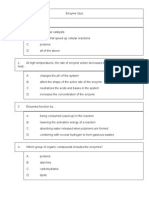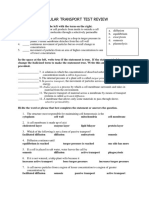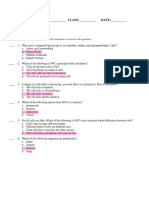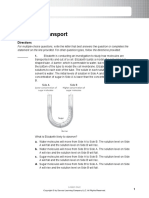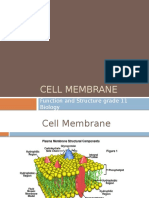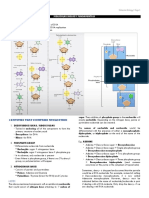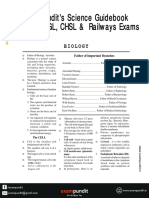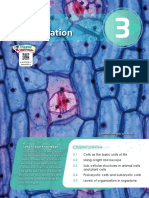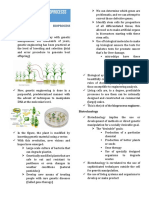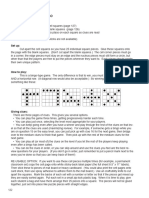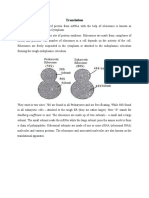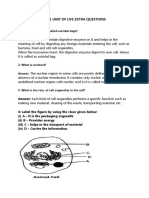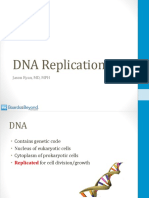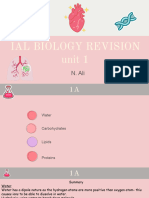Chapter 6 & 8 Test Key
Chapter 6 & 8 Test Key
Uploaded by
cshining33Copyright:
Available Formats
Chapter 6 & 8 Test Key
Chapter 6 & 8 Test Key
Uploaded by
cshining33Original Description:
Copyright
Available Formats
Share this document
Did you find this document useful?
Is this content inappropriate?
Copyright:
Available Formats
Chapter 6 & 8 Test Key
Chapter 6 & 8 Test Key
Uploaded by
cshining33Copyright:
Available Formats
Name: ___________________________________________________________ Date: ________________
Per._______
Chapters 6 and 8 Assessment
Part I: Multiple Choice (2 pts each, please select the best answer)
_____ 1. All of the following are part of a prokaryotic cell except:
A. DNA
B. A cell wall
C. A plasma membrane
D. Ribosomes
E. An endoplasmic reticulum
_____ 2. Which of the following is a major cause of the size limits for certain types of cells?
A. The evolution of larger cells after the evolution of smaller cells.
B. The difference in plasma membranes between prokaryotes and eukaryotes
C. The evolution of eukaryotes after the evolution of prokaryotes.
D. The need for surface area of sufficient area to allow the cell's functions.
E. The observation that longer cells usually have greater cell volume.
_____ 3. Large numbers of ribosomes are present in cells that specialize in producing which of
the following molecules?
A. Lipids
B. Starches
C. Proteins
D. Steroids
E. Glucose
_____ 4. Which type of organelle is primarily involved in the synthesis of oils, phospholipids, and
steroids?
A. Ribosome
B. Lysosome
C. Smooth endoplasmic reticulum
D. Mitochondrion
E. Contractile vacuole
_____ 5. Which of the following contains it's own DNA and ribosomes?
A. lysosome
B. Vacuole
C. Mitochondrion
D. Golgi apparatus
E. Peroxisome
_____ 6. Which of the following produces and modifies polysaccharides that will be secreted?
A. Lysosome
B. Vacuole
C. Mitochondrion
D. Golgi apparatus
E. Peroxisome
Name: ___________________________________________________________ Date: ________________
Per._______
_____ 7. Which of the following is a compartment that often takes up much of the volume of a
plant cell?
A. Lysosome
B. Vacuole
C. Mitochondrion
D. Golgi apparatus
E. Peroxisome
_____ 8. Which is one of the main energy transformers of cells?
A. Lysosome
B. Vacuole
C. Mitochondrion
D. Golgi apparatus
E. Peroxisome
_____ 9. Which of the following are capable of converting light energy to chemical energy?
A. Chloroplasts
B. Mitochondria
C. Leucoplasts
D. Peroxisomes
E. Golgi bodies
_____ 10. Which of the following relationships between cell structures in the respective functions
is correct?
A. Cell wall: support, protection
B. Chloroplast: cheap site of cellular respiration
C. Chromosomes: cytoskeleton of the nucleus
D. Ribosomes: secretion
E. Lysosomes: formation of ATP
_____ 11. Which structure is common to plant and animal cells?
A. Chloroplasts
B. Wall made of cellulose
C. Central vacuole
D. Mitochondrion
E. Centriole
_____ 12. Which of the following is (are) true for anabolic pathways?
a. They release energy as they degrade polymers to monomers.
b. They consume energy to decrease the entropy of the organism and its
environment.
c. They are usually highly spontaneous chemical reactions.
d. They do not depend on enzymes.
e. They consume energy to build up polymers from monomers.
_____ 13. Which of the following is a statement of the first law of thermodynamics?
a. Kinetic energy is stored energy that results from the specific arrangement of
matter.
b. Energy cannot be transferred or transformed.
c. Energy cannot be created or destroyed.
Name: ___________________________________________________________ Date: ________________
Per._______
d. The entropy of the universe is constant.
e. The entropy of the universe is decreasing.
_____ 14. Whenever energy is transformed, there is always an increase in the
a. entropy of the universe.
b. enthalpy of the universe.
c. entropy of the system.
d. free energy of the system.
e. free energy of the universe.
_____ 15. If an enzyme in solution is saturated with substrate, the most effective way to obtain a
faster yield of products is to
a. add more of the enzyme.
b. heat the solution to 90C.
c. add more substrate.
d. add a noncompetitive inhibitor.
e. add an allosteric inhibitor.
_____ 16. Choose the pair of terms that correctly completes this sentence: Catabolism is to
anabolism as _______ is to _______.
a. exergonic; spontaneous
b. entropy; enthalpy
c. exergonic; endergonic
d. free energy; entropy
e. work; energy
_____ 17. Reactants capable of interacting to form products in a chemical reaction must first
overcome a thermodynamic barrier known as the reaction's
a. endothermic level.
b. free-energy content.
c. entropy.
d. equilibrium point.
e. activation energy.
_____ 18. Which of the following statements regarding enzymes is true?
a. Enzymes increase the rate of a reaction by making the reaction more exergonic.
b. Enzymes increase the rate of a reaction by lowering the activation energy barrier.
c. Enzymes change the equilibrium point of the reactions they catalyze.
d. Enzymes make the rate of a reaction independent of substrate concentrations.
e. Enzymes increase the rate of a reaction by reducing the rate of reverse reactions.
Part II: Short Answer (4 points total, please use space provided for your response and/or the
back of this sheet)
Prompt: Although the similarities among cells reveal the evolutionary unity of life, cells can differ
dramatically in structure. Which aspects of cell structure best reveal their evolutionary unity?
You might also like
- Cell Transport WorksheetDocument2 pagesCell Transport WorksheetVictoria Niño D100% (1)
- CHE323-Biochemical Engineering 1 - PresentationDocument119 pagesCHE323-Biochemical Engineering 1 - PresentationPreciousNo ratings yet
- Cell Transport QuizDocument2 pagesCell Transport QuizDoreen Khrystel Gonzales100% (1)
- Cell Organelles Worksheet: Structure/Function Cell PartDocument2 pagesCell Organelles Worksheet: Structure/Function Cell PartKimora BrooksNo ratings yet
- Cell Membrane Coloring WorksheetDocument6 pagesCell Membrane Coloring WorksheetArleenaAmnaNo ratings yet
- Chapter 5 Membrane Structure and Function: Multiple Choice QuestionsDocument11 pagesChapter 5 Membrane Structure and Function: Multiple Choice QuestionsJohn MixerNo ratings yet
- ST Biology Nervous System IEP TestDocument3 pagesST Biology Nervous System IEP TestDanielle WilsonNo ratings yet
- Cell Membrane & Tonicity WorksheetDocument4 pagesCell Membrane & Tonicity Worksheetkeith tambaNo ratings yet
- Cell Transport WorksheetDocument3 pagesCell Transport WorksheetDat White Boi Player20% (1)
- Cell Test PracticeDocument7 pagesCell Test Practiceapi-240396878No ratings yet
- Ap Biology Mid Term PretestDocument30 pagesAp Biology Mid Term PretestKrisnavimala Krishnan0% (1)
- AP Biology Cells Test 09: Identify The Letter of The Choice That Best Completes The Statement or Answers The QuestionDocument12 pagesAP Biology Cells Test 09: Identify The Letter of The Choice That Best Completes The Statement or Answers The Questionchrwelch3No ratings yet
- Photosynthesis 1Document4 pagesPhotosynthesis 1Cotte Marchant LilloNo ratings yet
- Cell Organelle Review WorksheetDocument4 pagesCell Organelle Review WorksheetMae SilogNo ratings yet
- Biology PhotosynthesisDocument12 pagesBiology Photosynthesistiffycutie1No ratings yet
- Photosynthesis: Multiple ChoiceDocument23 pagesPhotosynthesis: Multiple ChoiceValentina RumhizhaNo ratings yet
- Final Bioa 2015Document10 pagesFinal Bioa 2015api-237801056100% (1)
- A.P. Chapter 8 WebTestDocument9 pagesA.P. Chapter 8 WebTestNick PirainoNo ratings yet
- Cell Membrane Coloring WorksheetDocument5 pagesCell Membrane Coloring WorksheetSophie Marriaga AlvarezNo ratings yet
- Cell Transport ReviewDocument2 pagesCell Transport ReviewRizza MoradaNo ratings yet
- 07 Test BankDocument46 pages07 Test Banke1153353No ratings yet
- Unit 2 - Macromolecules Guided Notes - 4th BlockDocument6 pagesUnit 2 - Macromolecules Guided Notes - 4th Blockapi-375285021No ratings yet
- Cell Processes Blank ReviewDocument4 pagesCell Processes Blank ReviewDr-Qussai ZuriegatNo ratings yet
- 2 - Cell TransportDocument2 pages2 - Cell Transportwjatau28No ratings yet
- Osmosis GizmoDocument6 pagesOsmosis GizmoCaleb Hutchinson0% (1)
- Cell Transport Review Worksheet: Complete The Table by Checking The Correct Column For Each StatementDocument3 pagesCell Transport Review Worksheet: Complete The Table by Checking The Correct Column For Each StatementMa.Janice GarciaNo ratings yet
- Cell Respiration WebQuest 2015Document3 pagesCell Respiration WebQuest 2015Haley HaunNo ratings yet
- SBI4U Quiz: Cellular Respiration-Kreb's CycleDocument3 pagesSBI4U Quiz: Cellular Respiration-Kreb's CycleParisa YahyaieNo ratings yet
- Cell Nuclear Division Paper 1 (Multiple Choices)Document6 pagesCell Nuclear Division Paper 1 (Multiple Choices)Tia wkwk100% (1)
- Aug 9 Sbi4u Quiz 4Document3 pagesAug 9 Sbi4u Quiz 4api-216300751No ratings yet
- Cell Membrane Coloring Worksheet With ANSWERSDocument6 pagesCell Membrane Coloring Worksheet With ANSWERSCortland Leslie100% (1)
- Multiple Choice Questions: Energy and MetabolismDocument75 pagesMultiple Choice Questions: Energy and MetabolismJing LiNo ratings yet
- 2 Y12 Cellular EnergeticsDocument12 pages2 Y12 Cellular Energeticssjjbio100% (1)
- Enzyme ReviewDocument2 pagesEnzyme ReviewSamura HasibNo ratings yet
- Photosynthesis TestDocument2 pagesPhotosynthesis TestCelle RichNo ratings yet
- Cell Bio Exam - LE - 10 - 11Document5 pagesCell Bio Exam - LE - 10 - 11tinateacherbkNo ratings yet
- Worksheet 15-ENZYMESDocument4 pagesWorksheet 15-ENZYMESNaz BasaranNo ratings yet
- GIZMOS RNA Protein Synthesis LabDocument4 pagesGIZMOS RNA Protein Synthesis LabjhonNo ratings yet
- The Cell Cycle and Cancer Virtual Lab InstructionsDocument2 pagesThe Cell Cycle and Cancer Virtual Lab InstructionsKayla LyNo ratings yet
- SBI4U0: Examination and Course Review: Unit 1: BiochemistryDocument6 pagesSBI4U0: Examination and Course Review: Unit 1: BiochemistrySukhvir AujlaNo ratings yet
- Student Exploration: Cell StructureDocument8 pagesStudent Exploration: Cell Structurelingesh tamizhanNo ratings yet
- Enzyme QuizDocument9 pagesEnzyme Quizerin_slatenNo ratings yet
- Cellular Transport Test Review-OkDocument4 pagesCellular Transport Test Review-OkSri Widowati100% (1)
- Cell Structure and FunctionDocument8 pagesCell Structure and FunctionTshibambeNo ratings yet
- MYP Exercises. Cell Respiration.: AnswerDocument4 pagesMYP Exercises. Cell Respiration.: AnswerRishar bokNo ratings yet
- Kami Export - MARC LOUIS - Biology Test Cell StructureDocument6 pagesKami Export - MARC LOUIS - Biology Test Cell StructureMarc LouisNo ratings yet
- Cells Study Guide 2020 KEYDocument4 pagesCells Study Guide 2020 KEYLaarni GeeNo ratings yet
- Cell Membrane Worksheet 1 PDFDocument4 pagesCell Membrane Worksheet 1 PDFVidanes, Earl JosephNo ratings yet
- Cell Transport: Lesson QuizDocument3 pagesCell Transport: Lesson QuizIsabella Hosman RojasNo ratings yet
- Chapter 6 How Cells Harvest Chemical Energy: Campbell's Biology: Concepts and Connections, 7e (Reece Et Al.)Document16 pagesChapter 6 How Cells Harvest Chemical Energy: Campbell's Biology: Concepts and Connections, 7e (Reece Et Al.)Yazmin QuevedoNo ratings yet
- Chapter 10 Multiple Choice Practice: CO H O O PDocument7 pagesChapter 10 Multiple Choice Practice: CO H O O PShaira CogollodoNo ratings yet
- CH 7 Part I TESTDocument7 pagesCH 7 Part I TESTlshawNo ratings yet
- Question and Answers Membrane Transport Extended Response QuestionDocument4 pagesQuestion and Answers Membrane Transport Extended Response QuestionJohn OsborneNo ratings yet
- AP Biology Cell Respiration Quiz Study Guide ANSWERSDocument4 pagesAP Biology Cell Respiration Quiz Study Guide ANSWERSRam LouNo ratings yet
- AP BIO MACROMOLECULES Chapter 5 ReviewDocument35 pagesAP BIO MACROMOLECULES Chapter 5 Reviewsheila may valiao-de asisNo ratings yet
- Cell Membrane: Function and Structure Grade 11 BiologyDocument51 pagesCell Membrane: Function and Structure Grade 11 BiologyChester WengerNo ratings yet
- Grade 11 Biology Genetics TestDocument3 pagesGrade 11 Biology Genetics TestValerieNo ratings yet
- Chapter 7 TestDocument8 pagesChapter 7 Testkwilliams1994No ratings yet
- Bio 1 - Lesson 8 QuizDocument3 pagesBio 1 - Lesson 8 QuizPaul Omar Pastrano100% (1)
- Exam Biology 1st QuarterDocument7 pagesExam Biology 1st QuarterAhmed NasrNo ratings yet
- Mtap I - Molbio - NotesDocument30 pagesMtap I - Molbio - NotesKath CamacamNo ratings yet
- Sistem Peredaran Darah MamaliaDocument6 pagesSistem Peredaran Darah MamaliaAlfian IskandarNo ratings yet
- The CellDocument8 pagesThe CellJessa Nicole ReteracionNo ratings yet
- Bharti 1927Document19 pagesBharti 1927vikasNo ratings yet
- ENVS 532: DR Assad Al-Thukair Associate ProfessorDocument16 pagesENVS 532: DR Assad Al-Thukair Associate ProfessorAbu Muhsin Al NgapakyNo ratings yet
- Science Guidebook For SSC CGL, CHSL, Railways & PSC Exams - Exampundit - in PDFDocument55 pagesScience Guidebook For SSC CGL, CHSL, Railways & PSC Exams - Exampundit - in PDFvilas bollabathiniNo ratings yet
- Biology For CAPE Chapter 5 AnswersDocument6 pagesBiology For CAPE Chapter 5 AnswersFiveLimaRomeoNo ratings yet
- Genetic Code HMDocument30 pagesGenetic Code HMdrhmpatel100% (2)
- Chapter 3 (For Chapter 2 LG) ReferenceDocument44 pagesChapter 3 (For Chapter 2 LG) ReferenceMi KaNo ratings yet
- C Science 10 Quarter 3 Module 3 (Week 4)Document14 pagesC Science 10 Quarter 3 Module 3 (Week 4)Daisy Soriano Prestoza100% (1)
- Module 1 - Biochemical EngineeringDocument43 pagesModule 1 - Biochemical EngineeringAllyssa BadilloNo ratings yet
- Cell BingoDocument6 pagesCell BingoArcely DavidNo ratings yet
- Chapter 3 Subcellular Fractionation and Isolation of OrganellesDocument8 pagesChapter 3 Subcellular Fractionation and Isolation of OrganellesrajaNo ratings yet
- Molecular Biology Notes 1 PDFDocument23 pagesMolecular Biology Notes 1 PDFChris_Barber09100% (3)
- SHENIBLOG-Class 10 Biology Focus Area Covered Notes (Eng Med) All Chapters 2022Document16 pagesSHENIBLOG-Class 10 Biology Focus Area Covered Notes (Eng Med) All Chapters 2022kailaskrishnaushusNo ratings yet
- General Science 2024 Mock Test 4th April, 2024Document27 pagesGeneral Science 2024 Mock Test 4th April, 2024Hrxla BualteNo ratings yet
- TranslationDocument12 pagesTranslationHarshit YadavNo ratings yet
- The Fundamental Unit of Life Extra Questions: 1: Why Are Lysosomes Called Suicidal Bags? AnswerDocument6 pagesThe Fundamental Unit of Life Extra Questions: 1: Why Are Lysosomes Called Suicidal Bags? Answerhello dayNo ratings yet
- CellBiologySlides2022 FullSizeDocument363 pagesCellBiologySlides2022 FullSizerithesh reddyNo ratings yet
- Biology Dna Worksheet Answer KeyDocument4 pagesBiology Dna Worksheet Answer KeyElena abigail silva vallecilloNo ratings yet
- Expert MdcatDocument4 pagesExpert Mdcathely shahNo ratings yet
- Essay 3Document3 pagesEssay 3Tri HardiyantiNo ratings yet
- IAL Edexcel Biology AS Unit 1 RevisionDocument42 pagesIAL Edexcel Biology AS Unit 1 Revisionschoolnada19No ratings yet
- Biology PDFDocument120 pagesBiology PDFketakeeNo ratings yet
- Cell Structure 3Document30 pagesCell Structure 3Rohan PaneruNo ratings yet
- Ice Btech FT Syllabus r2007Document92 pagesIce Btech FT Syllabus r2007Aishu1385No ratings yet
- 2022 Nucleic Acid and Gene Expression Problem Set (Teacher)Document28 pages2022 Nucleic Acid and Gene Expression Problem Set (Teacher)Sundaravadivel Prabhav (Njc)No ratings yet
- 2.7 DNA Replication, Transcription and TranslationDocument46 pages2.7 DNA Replication, Transcription and TranslationAcyl HoteitNo ratings yet
- G (12) Ls Life Science 2020-2021 Revision Sheet:2 Proteosythesis Part-1-IDocument2 pagesG (12) Ls Life Science 2020-2021 Revision Sheet:2 Proteosythesis Part-1-IJoelle AssafNo ratings yet
















